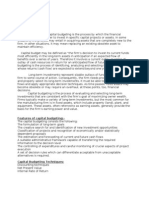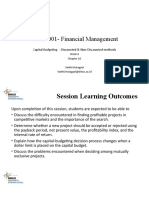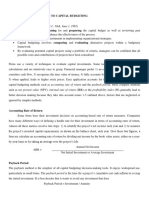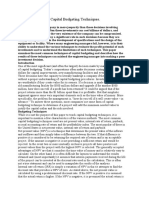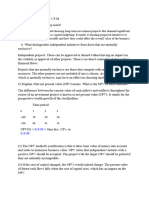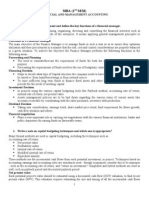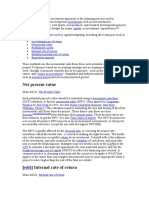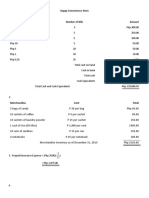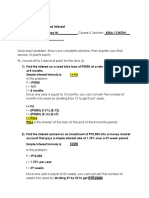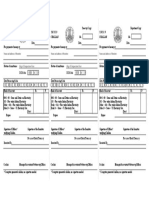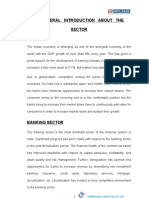Corporate Finance Fundamentals
Managers of publicly traded corporations have a fiduciary responsibility to maximize the
current value of existing shares outstanding.
One way to think about fiduciary duty: A company’s objective is to construct a portfolio
(collection) of assets that, when combined, generates value greater than the cost of the
portfolio of assets.
Types of assets: Real/Economic vs. Financial
Real (or economic) assets can be consumed or used in a production process, whereas
financial assets (e.g. stocks, bonds, derivatives) represent claims to cash flows generated
by real assets or ownership rights of real assets.
Real assets can be tangible assets like real estate, manufacturing equipment, gold, raw
materials inventory, etc. or they can be intangible assets like patents, trademarks,
human capital, brand name, etc.
The Balance Sheet View of the Firm:
The accounting identity must hold in book value terms (i.e. at cost) and in market value
terms.
Assets = Liabilities + Owner’s Equity
The assets that the firm holds are either owned (equity) or owed on (liabilities). This
equation also implies that the assets the firm holds must be financed somehow.
Broadly speaking, there are three ways financial managers can impact shareholder value:
1) Capital budgeting decisions: What assets should the firm hold? Predominant focus
here is on real assets, although financial institutions
2) Capital structure/payout policy decisions: What mix of financial assets should the
firm issue to finance the assets it holds (see accounting identity above) ? Should the
firm distribute cash to shareholders, and if so, what form should that take?
3) Working capital management: To whom and under what terms should the firm
extend credit? How much inventory should the firm hold? How should the firm
utilize and manage trade credit (e.g. accounts payable)?
The Euroland Foods case that we cover during the case analysis workshop focuses on capital
budgeting decisions.
The academic-preferred capital budgeting decision rule is the net present value (NPV) rule:
Firms should undertake all positive NPV projects. When facing a set of mutually
exclusive investment projects, firms should take the project with the highest NPV.
There are other decision criteria outlined below, along with an example of how the profitability
index might be useful in a situation where the firm faces financial constraints.
�Criterion Definition/Calculation/Drawbacks Decision Rule
Net Present The net present value is the sum of Accept project if NPV > 0.
Value (NPV) discounted free flows from the project If evaluating mutually
minus (net of) the initial investment. The exclusive projects with
NPV is a direct measure of the value identical lives, accept
created by a project. project with highest NPV.
Payback The payback period is the amount of time Accept if payback period is
Period it takes for the free cash flows of a project less than some specified
to pay back the initial investment period of time
expenditure. Problem: it fails to take into
account time value of money.
Discounted Similar to the payback period. The Accept if discounted
Payback discounted payback period is the amount payback period is less than
Period of time it takes for the present value of some specified period of
free cash flows ((i.e. discounted by cost of time.
capital, r) to pay back the initial
investment expenditure.
Average Average accounting return is the average Accept if AAR is greater
Accounting project net income over the life of the than some target AAR.
Return (AAR) project divided by the average book value
of assets of the project. Note that book
value will include PP&E, net and
operationally related net working capital
associated with the project. Problems:
Net Income ≠ Cash Flow,
Average over life of project, so it ignores
time value of money
Internal Rate The internal rate of return is the return Accept if IRR is greater
of Return (IRR) that, when used as the discount rate in a than the firm’s cost of
discounted cash flow (DCF) analysis, yields capital or required return
an NPV of 0. Generally, if the IRR decision or hurdle rate (all of these
rule is consistent with the NPV rule. Two terms get used
exceptions: synonymously and
1. If a project has cash flows which effectively mean the same
change signs (i.e. from negative to thing)
positive) more than once, then
there is more than one IRR.
2. When comparing two mutually
exclusive projects, the one with
the highest IRR does not
necessarily have the highest NPV,
and therefore might create less
value for shareholders.
�Modified The MIRR is similar to the IRR. The key Accept if MIRR is greater
Internal Rate difference is that it adjusts the cash flows than cost of capital or
of Return (e.g. by discounting all negative cash flows required return or hurdle
(MIRR) to time 0) so that there is only one sign rate.
change in the cash flows. The result: only
one IRR. Problem: At what rate should
you discount cash flows? If cost of
capital, then why not find NPV of project
and use the NPV criteria? Also, doesn’t
work for mutually exclusive projects.
Profitability The profitability index is calculated by If funds are unlimited and
Index (PI) dividing the present value of future free projects are not mutually
cash flows by the initial investment (do exclusive, then accept
not include the minus sign on the project if PI>1. If funds are
investment). If PI is greater than 1, then limited or projects are
the present value of future cash flows is mutually exclusive, no real
greater than the initial investment, and criteria exists.
the NPV is, therefore, positive. Problem:
PI does not measure total NPV of project,
so may not be best measure for
comparing mutually exclusive projects.
Advantage: It measures the NPV per $1
invested and may be useful for scalable
projects (i.e. firm can increase or decrease
level of investment) and for firms where
limited investment funds are available.
Equivalent To calculate the equivalent annuity cash If projects cannot be
Annuity Cash flow, first calculate the NPV of the project. renewed indefinitely, then
Flow (EAC) Then, annuitize the NPV over the project’s EAC is not a valid measure
life at the firm’s wacc. That annuity of comparison. NPV is
payment is the EAC. The EAC is better if projects have
particularly useful for comparing projects finite, non-extendable
with unequal lives. Assuming that lives.
projects can be renewed indefinitely
when they expire, the EAC may be more
appropriate than the NPV.
�Example of how the profitability index might be useful:
A Firm has $10,000,000 to allocate across investments. The table below lists the
available investment opportunities, the initial investment outlay (in millions), the present value
of free cash flows (in millions), the NPV (in millions), and the PI. Only one project per color can
be undertaken (i.e. the projects are mutually exclusive), but the firm does not have to take a
project of each color.
Investmen
t PV(FCF) NPV PI
A 5 8 3 1.60
B 6 10 4 1.67
C 2 4.25 2.25 2.13
D 3 5.5 2.5 1.83
E 3 6 3 2.00
F 4 7.5 3.5 1.88
The NPV rule and the PI both suggest accepting project B over Project A. According to
the NPV rule, the firm should choose D over C, but PI says take C over D. NPV rule suggests
taking Project F, but PI says take project E.
Because the firm is financially constrained, consider looking at the PI, and start with the
highest PI project. Accept project C (and reject D). Then accept project E (and reject F). C and
E combined require an investment of $5 million. That leaves only $5 million left—not enough
to pursue project B. The firm does have enough for project A, and it should accept project A,
because it has a positive NPV, so it creates value, even though project B has a higher PI and
NPV. Combined, the firm invests $10 million in projects with an NPV of $8.25 million.
If we were to use NPV as our guide, we could start with the project with the highest
NPV, project B. Accept B over A. Then, accept F over E. This yields a combined NPV of $7.5
million on $10 million investment, and is the next best option to the combination created by
using the PI.








